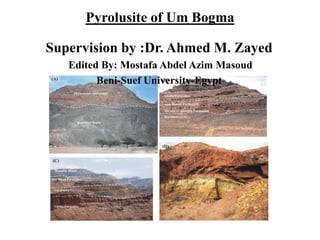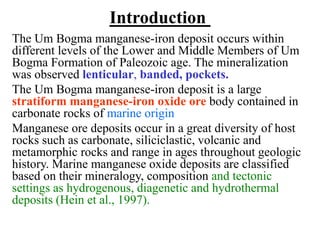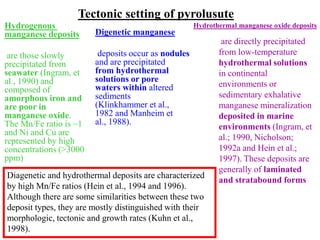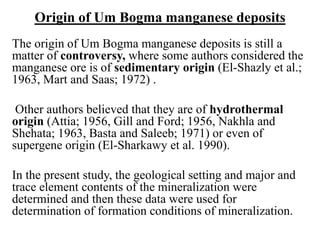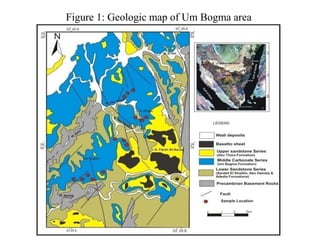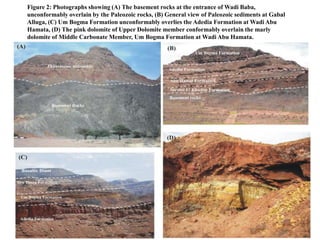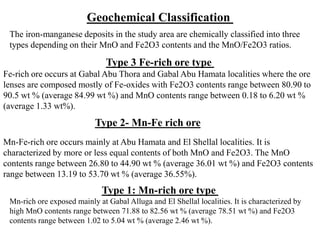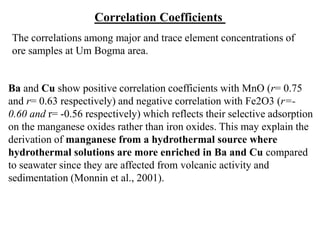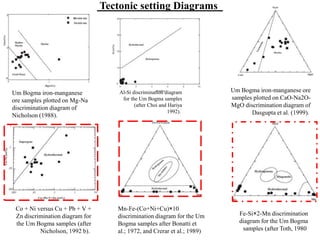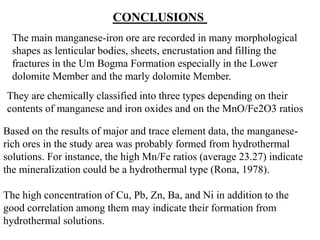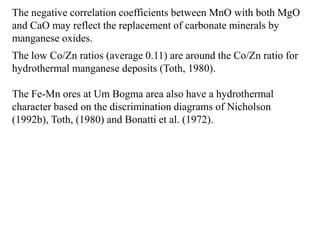Pyrolusite of Umm Bogma, South Sinai, Egypt
- 1. Pyrolusite of Um Bogma Supervision by :Dr. Ahmed M. Zayed Edited By: Mostafa Abdel Azim Masoud Beni-Suef University-Egypt
- 2. Introduction The Um Bogma manganese-iron deposit occurs within different levels of the Lower and Middle Members of Um Bogma Formation of Paleozoic age. The mineralization was observed lenticular, banded, pockets. The Um Bogma manganese-iron deposit is a large stratiform manganese-iron oxide ore body contained in carbonate rocks of marine origin Manganese ore deposits occur in a great diversity of host rocks such as carbonate, siliciclastic, volcanic and metamorphic rocks and range in ages throughout geologic history. Marine manganese oxide deposits are classified based on their mineralogy, composition and tectonic settings as hydrogenous, diagenetic and hydrothermal deposits (Hein et al., 1997).
- 3. are directly precipitated from low-temperature hydrothermal solutions in continental environments or sedimentary exhalative manganese mineralization deposited in marine environments (Ingram, et al.; 1990, Nicholson; 1992a and Hein et al.; 1997). These deposits are generally of laminated and stratabound forms Hydrogenous manganese deposits are those slowly precipitated from seawater (Ingram, et al., 1990) and composed of amorphous iron and are poor in manganese oxide. The Mn/Fe ratio is ~1 and Ni and Cu are represented by high concentrations (>3000 ppm) Digenetic manganese deposits occur as nodules and are precipitated from hydrothermal solutions or pore waters within altered sediments (Klinkhammer et al., 1982 and Manheim et al., 1988). Hydrothermal manganese oxide deposits Tectonic setting of pyrolusute Diagenetic and hydrothermal deposits are characterized by high Mn/Fe ratios (Hein et al., 1994 and 1996). Although there are some similarities between these two deposit types, they are mostly distinguished with their morphologic, tectonic and growth rates (Kuhn et al., 1998).
- 4. Origin of Um Bogma manganese deposits The origin of Um Bogma manganese deposits is still a matter of controversy, where some authors considered the manganese ore is of sedimentary origin (El-Shazly et al.; 1963, Mart and Saas; 1972) . Other authors believed that they are of hydrothermal origin (Attia; 1956, Gill and Ford; 1956, Nakhla and Shehata; 1963, Basta and Saleeb; 1971) or even of supergene origin (El-Sharkawy et al. 1990). In the present study, the geological setting and major and trace element contents of the mineralization were determined and then these data were used for determination of formation conditions of mineralization.
- 5. Figure 1: Geologic map of Um Bogma area
- 6. Figure 2: Photographs showing (A) The basement rocks at the entrance of Wadi Baba, unconformably overlain by the Paleozoic rocks, (B) General view of Paleozoic sediments at Gabal Alluga, (C) Um Bogma Formation unconformably overlies the Adedia Formation at Wadi Abu Hamata, (D) The pink dolomite of Upper Dolomite member conformably overlain the marly dolomite of Middle Carbonate Member, Um Bogma Formation at Wadi Abu Hamata.
- 7. Mn-Fe-rich ore occurs mainly at Abu Hamata and El Shellal localities. It is characterized by more or less equal contents of both MnO and Fe2O3. The MnO contents range between 26.80 to 44.90 wt % (average 36.01 wt %) and Fe2O3 contents range between 13.19 to 53.70 wt % (average 36.55%). Type 3 Fe-rich ore type Fe-rich ore occurs at Gabal Abu Thora and Gabal Abu Hamata localities where the ore lenses are composed mostly of Fe-oxides with Fe2O3 contents range between 80.90 to 90.5 wt % (average 84.99 wt %) and MnO contents range between 0.18 to 6.20 wt % (average 1.33 wt%). Type 2- Mn-Fe rich ore Type 1: Mn-rich ore type Mn-rich ore exposed mainly at Gabal Alluga and El Shellal localities. It is characterized by high MnO contents range between 71.88 to 82.56 wt % (average 78.51 wt %) and Fe2O3 contents range between 1.02 to 5.04 wt % (average 2.46 wt %). Geochemical Classification The iron-manganese deposits in the study area are chemically classified into three types depending on their MnO and Fe2O3 contents and the MnO/Fe2O3 ratios.
- 8. Correlation Coefficients The correlations among major and trace element concentrations of ore samples at Um Bogma area. Ba and Cu show positive correlation coefficients with MnO (r= 0.75 and r= 0.63 respectively) and negative correlation with Fe2O3 (r=- 0.60 and r= -0.56 respectively) which reflects their selective adsorption on the manganese oxides rather than iron oxides. This may explain the derivation of manganese from a hydrothermal source where hydrothermal solutions are more enriched in Ba and Cu compared to seawater since they are affected from volcanic activity and sedimentation (Monnin et al., 2001).
- 9. Tectonic setting Diagrams Um Bogma iron-manganese ore samples plotted on Mg-Na discrimination diagram of Nicholson (1988). Um Bogma iron-manganese ore samples plotted on CaO-Na2O- MgO discrimination diagram of Dasgupta et al. (1999). Al-Si discrimination diagram for the Um Bogma samples (after Choi and Hariya 1992). Fe-SiĂ—2-Mn discrimination diagram for the Um Bogma samples (after Toth, 1980 Co + Ni versus Cu + Pb + V + Zn discrimination diagram for the Um Bogma samples (after Nicholson, 1992 b). Mn-Fe-(Co+Ni+Cu)Ă—10 discrimination diagram for the Um Bogma samples after Bonatti et al.; 1972, and Crerar et al.; 1989)
- 10. CONCLUSIONS The main manganese-iron ore are recorded in many morphological shapes as lenticular bodies, sheets, encrustation and filling the fractures in the Um Bogma Formation especially in the Lower dolomite Member and the marly dolomite Member. They are chemically classified into three types depending on their contents of manganese and iron oxides and on the MnO/Fe2O3 ratios Based on the results of major and trace element data, the manganese- rich ores in the study area was probably formed from hydrothermal solutions. For instance, the high Mn/Fe ratios (average 23.27) indicate the mineralization could be a hydrothermal type (Rona, 1978). The high concentration of Cu, Pb, Zn, Ba, and Ni in addition to the good correlation among them may indicate their formation from hydrothermal solutions.
- 11. The negative correlation coefficients between MnO with both MgO and CaO may reflect the replacement of carbonate minerals by manganese oxides. The low Co/Zn ratios (average 0.11) are around the Co/Zn ratio for hydrothermal manganese deposits (Toth, 1980). The Fe-Mn ores at Um Bogma area also have a hydrothermal character based on the discrimination diagrams of Nicholson (1992b), Toth, (1980) and Bonatti et al. (1972).
- 12. References • Khalifa, I. H., & Seif, R. A. (2014). Geochemistry of manganese-iron ores at Um Bogma area, west central Sinai, Egypt. International Journal of Advanced Scientific and Technical Research, 6, 258- 283.

